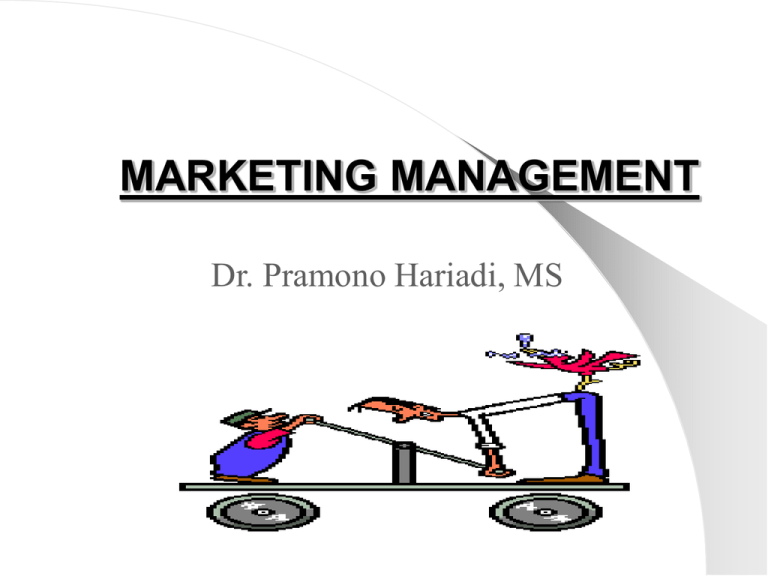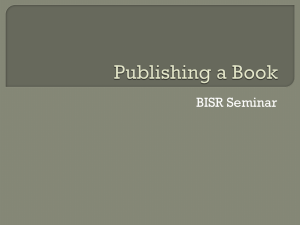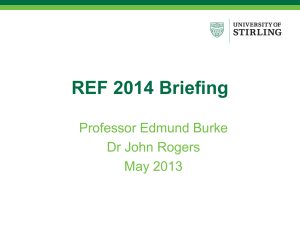THE BCG MATRIX
advertisement

MARKETING MANAGEMENT Dr. Pramono Hariadi, MS DEFINISI “Marketing adalah penciptaan dan penyampaian standar hidup yang lebih tinggi”. “Marketing adalah proses manajerial dan sosial dengan cara ini individu dan kelompok menemukan apa yang mereka butuhkan (need) dan inginkan (want) melalui penciptaan, penawaran dan pertukaran nilai barang dan jasa dengan pihak lain”. Kata kunci Kebutuhan (needs) dan Keinginan (wants) pelanggan Permintaan dan pasar Pilihan, dalam upaya memaksimalkan nilai atau kegunaan PROSES PEMASARAN Pemasaran Kebutuhan, Keinginan, Permintaan Produk P E N J U A L A N M A R K E T T I N G Nilai biaya Kepuasan Pertukaran, Transaksi, hubungan Pasar SCOPE MARKETING Marketers terkait dengan 10 hal: 1. Physical Goods 2. Services 3. Experiences 4. Events 5. Persons 6. Places 7. Properties 8. Organizations 9. Information 10. Ideas A SIMPLE MARKETING SYSTEM COMMUNICATION GOODS & SERVICES INDUSTRY (A collection of sellers) MONEY INFORMATION MARKET (A collection of buyers) STRUKTUR PRTUKARAN PADA EKONOMI MODERNS Resources Resources Resource Markets Money Taxes & Goods Manufacturer Markets S&m Government Markets Money Services & Money Services Consumer Markets Taxes Taxes & Goods S&m T&g Money Money Intermediary Markets Goods & Services Goods & Services KONSEP-KONSEP PEMASARAN Ada lima jenis konsep marketing: The PRODUCTION CONCEPT : konsumen lebih menyukai produk yang tersedia secara luas di pasar dan murah. The PRODUCT CONCEPT: konsumen menyukai suatu produk yang memiliki kelebihan kualitas, penampilan atau fitur yang inovatif . The SELLING CONCEPT : konsumen tidak akan membeli produk perusahaan cukup banyak, oleh karena itu perusahaan harus melakukan upaya penjualan dan promosi. The MARKETING CONCEPT : kunci pencapaian tujuan perusahaan adalah dalam penciptaan, penghantaran dan komunikasi nilai pelanggan yang lebih efektif terhadap sasaran pasar yang telah ditetapkan. The SOCIETAL MARKETING : tugas organisasi (perusahaan) adalah untuk menetapkan kebutuhan, keinginan dan ketertarikan konsumen yang menjadi sasaran pasar serta menghantarkan kepuasan yang dibutuhkan yang lebih efektif dari pesaing. The Core Concepts of Marketing 1 3 2 Needs Value Products Wants Demands Cost Satisfaction 4 Exchanges Transactions Relationships 6 5 Marketing Markets Marketers CUSTOMER RELATIONSHIPS CREATING CUSTOMER VALUE AND SATISFACTION Total customer value: the bundle of benefits customers expect from a given product or service. Total customer cost: the bundle of costs customers expect to incur in evaluating, obtaining, using, and disposing of the product or service. Customer delivered value: the difference between total customer value and total customer cost. (continued) CREATING CUSTOMER VALUE AND SATISFACTION Example of Customer Delivered Value: a) Buyers perception of offer’s worth = Rp.200,000,b) Company’s cost of manufacture = Rp.140,000,c) Company’s price = Rp.160,000,1. Customer Delivered Value: = Rp.40,000,2. Customer Delivered Value: = 1.25 (as a ratio) (continued) CREATING CUSTOMER VALUE AND SATISFACTION Customer Satisfaction: Whether a customer is satisfied after purchase depends on the offer’s performance in relation to the buyer’s expectations. We may define it as: “Customer satisfaction or dissatisfaction is a person’s feeling of pleasure or disappointment resulting from comparing a product’s perceived performance (or outcome) in relation to the person’s expectations”. THE NATURE OF HIGH PERFORMANCE BUSINESSES Set strategies to satisfy key stakeholders … … by improving critical business processes … … and aligning resources and organization. STAKEHOLDERS PROCESSES RESOURCES ORGANIZATION MARKET-ORIENTED STRATEGIC PLANNING Ref: Chapter 4 of Core Text STRATEGIC PLANNING: THE FOUR LEVELS Most large companies consist of four organizational levels: The Corporate level The Division level The Business Unit level The Product level THE STRATEGIC PLANNING, IMPLEMENTATION & CONTROL PROCESSES PLANNING IMPLEMENTING Corporate Planning Organizing Division Planning Implementing Business Planning Product Planning CONTROLLING Measuring Results Diagnosing Results Taking Corrective Action DEFINING THE CORPORATE MISSION Peter Drucker’s Classic Questions: 1. What is our business? 2. Who is the customer? 3. What is value to the customer? 4. What will our business be? 5. What should our business be? Ref: Chapter 4 of core Text GOOD MISSION STATEMENTS Good mission statements have three major characteristics: 1. They focus on limited number of goals. 2.They stress the major policies and values the company wants to honor. 3. They define the major competitive scopes within which the company will operate. Ref: Chapter 4 of Core Text COMPETITIVE SCOPES OF A COMPANY Industry scope Products and applications scope Competence scope Market segment scope Vertical scope Geographical scope Ref: Chapter 4 of Core Text ESTABLISHING STRATEGIC BUSINESS UNITS Large companies normally manage different businesses, each requiring its own strategy. These are termed as Strategic Business Units (SBUs). An SBU has three characteristics: It is a single business or a collection of related businesses that can be planned separately from the rest of the company. It has its own set of competitors. It has a manager who is responsible for strategic planning and profit performance and who controls most of the factors affecting profit. Ref: Chapter 4 of Core Text ASSIGNING RESOURCES TO SBUs (THE BCG GROWTH-SHARE MATRIX) The Boston Consulting Group (BCG), a leading management consulting firm, popularized the growthshare matrix. It is divided into four cells, each indicating a different type of business. The marketgrowth rate on the vertical axis indicates the annual growth rate of the market in which the business operates. The relative market share, measured on the horizontal axis, refers to the SBUs market share relative to that of the largest competitor in the segment. Ref: Chapter 4 of Core Text THE BCG GROWTH-SHARE MATRIX RELATIVE MKT SHARE 20% STARS QUESTION MARKS MKT GROWTH 10% DOGS 0% CASH COWS 10x 1x 0.1x Marketing Management Marketing Factors Product Purchase Process Personal & Environmental Factors Problem Recognition Information Seeking Price Place Promotion Evaluation of Alternatives Purchase Decision PostPurchase Evaluation Psychological Personal Social Cultural Market Segmentation Segmentation is dividing the market into groups whose members have similar characteristics. Levels of segmentation: – Mass marketing – sell the same product to as many perole as possible – Niche Marketing – finding small/profitable market segments and designing for them – One-to-One Marketing – unique mix of goods and services for each customer Best segmentation is to use many bases to come up with a target market that is sizeable, reachable and profitable. Market Segmentation: Target Marketing Target market: – any group of potential customers who have similar wants and needs and can be expected to show interest in the same products – Focus on: Geographic region Customer demographics Customer psychographics Product-use variables THE BCG MARIX (CONTD) QUESTION MARKS: New businesses of the company in high growth-rate markets. STARS: Successful Question-mark businesses become stars that gain market share and generate profits for the company. CASH COWS: When market-growth rate slows down as competitors enter the segment, businesses that remain successful become Cash Cows. They fund Stars and new Question-mark businesses. DOGS: These are businesses in decline and the company has the option to “harvest” or “divest”. THE MARKETING PROCESS The Marketing Process consists of: Analyzing Marketing Opportunities Researching and Selecting Target Markets Designing Marketing Opportunities Planning Marketing Programs Organizing, Implementing, and Controlling the Marketing Effort Ref: Chapter 4 of Core Text MARKETING ENVIRONMENT & SYSTEM Ref: Chapter 6 of Core Text MARKETING ENVIRONMENT FACTORS Demographic Environment Economic Environment Natural Environment Technological Environment Political-legal Environment Social-cultural Environment DEMOGRAPHIC ENVIRONMENT Worldwide Population Growth Population Age Mix Ethnic Markets Educational Groups Household Patterns Geographical Shifts in Population Shift from Mass to Micromarkets Ref: Chapter 6 of Core Text ECONOMIC ENVIRONMENT Income Distribution Subsistence economies Raw-material-exporting economies Industrializing economies Industrial economies Savings, Debt, and Credit Availability Ref: Chapter 6 of Core Text NATURAL ENVIRONMENT Shortage of Raw Materials Increased Energy Costs Increased Pollution Levels Changing Role of Governments Ref: Chapter 6 of Core Text TECHNOLOGICAL ENVIRONMENT Accelerating Pace of Technological Change Unlimited Opportunities for Innovation Varying R&D Budgets Increased Regulation of Technological Change Ref: Chapter 6 of Core Text POLITICO-LEGAL ENVIRONMENT Legislation Growth Regulating Business: of Special Interest Groups Ref: Chapter 6 of Core Text SOCIO-CULTURAL ENVIRONMENT Persistence of Core Cultural Values: Core beliefs Secondary beliefs Existence of Subcultures Shifts of Secondary Cultural Values Through Time Ref: Chapter 6 of Core Text ANALYZING CONSUMER BEHAVIOR Ref: Chapter 7 of Core Text ANALYZING CONSUMER BEHAVIOR FACTORS INFLUENCING CONSUMER BEHAVIOR BUYING ROLES TYPES OF BUYING BEHAVIOR THE BUYING DECISION PROCESS Ref: Chapter 7 of Core Text FACTORS INFLUENCING CONSUMER BEHAVIOR CULTURAL FACTORS: Culture Sub-culture Social Class SOCIAL FACTORS: Reference groups Family Roles & statuses Ref: Chapter 7 of Core Text FACTORS INFLUENCING CONSUMER BEHAVIOR(2) PERSONAL FACTORS Age and Life-Cycle Stage Occupation Economic Circumstances Lifestyle Personality & Self-concept Ref: Chapter 7 of Core Text FACTORS INFLUENCING CONSUMER BEHAVIOR (3) PSYCHOLOGICAL FACTORS Motivation Learning Perception Beliefs & Attitudes Ref: Chapter 7 of Core Text BUYING ROLES INITIATOR: The first person to suggest the idea of buying. INFLUENCER: A person whose views impact the buying decision. DECIDER: The person who decides on what, when & where to buy the product or service. BUYER: The actual purchaser. USER: The person who uses/consumes the product or service. Ref: Chapter 7 of Core Text TYPES OF BUYING BEHAVIOR DEGREE OF INVOLVEMENT HIGH HIGH DEGREE OF DIFFERENCES IN BRANDS LOW LOW COMPLEX BUYING BEHAVIOR VARIETYSEEKING BUYING BEHAVIOR DISSONANCEREDUCING BUYING BEHAVIOR HABITUAL BUYING BEHAVIOR TYPES OF BUYING BEHAVIOR COMPLEX BUYING BEHAVIOR: High involvement, very expensive, infrequently purchased,very risky, self-expressive products (designer jewelry, custom-designed sports cars, housing). DISSONANCE REDUCING BUYING BEHAVIOR: High involvement, expensive, infrequently purchased, self-expressive products (furniture, white goods, PCs). Ref: Chapter 7 of Core Text TYPES OF BUYING BEHAVIOR (CONTD) VARIETY SEEKING BUYING BEHAVIOR: Low involvement, frequently purchased, inexpensive products (pastries, biscuits, snacks). HABITUAL BUYING BEHAVIOR: Low involvement, frequently purchased, inexpensive products (sugar, salt, flour, commodities). Ref: Chapter 7 of Core Text THE BUYING DECISION PROCESS Problem/need Recognition Information Search Evaluation Of Purchase Alternatives Decision Postpurchase Behavior Ref: Chapter 7 of Core Text PROBLEM/NEED RECOGNITION From Internal Stimuli: Hunger Thirst Fear From External Stimuli: Neighbor’s Purchases Advertisements Window Shopping Newspapers & Magazines Ref: Chapter 7 of Core Text INFORMATION SEARCH From Personal Sources: Family Friends Neighbors Acquaintances From Commercial Sources: Advertisements Dealers Salespersons Packaging Displays Ref: Chapter 7 of Core Text INFORMATION SEARCH (CONTD) From Commercial Sources: Advertisements Dealers Salespersons Packaging Displays Ref: Chapter 7 of Core Text INFORMATION SEARCH (CONTD) From Public Sources: Mass Media Chambers of Commerce Consumer Rating Magazines From Experiential Sources: Handling the Product Examining the Product Using the Product Ref: Chapter 7 of Core Text EVALUATION OF ALTERNATIVES Successive Sets in Consumer Decision-Making: Total Set Awareness Set Consideration Set Choice Set Buying Decision (continued) Ref: Chapter 7 of Core Text EVALUATION OF ALTERNATIVES TOTAL SET AWARENESS SET CONSIDERATION SET CHOICE SET BUYING DECISION Ref: Chapter 7 of Core Text PURCHASE DECISION Interfering Factors: Attitudes of Others: Opposing and intense opinions of family members, close friends and acquaintances Unanticipated situational factors: Changes in income, job transfer, loss of employment, change of priority e.g. sudden payment of educational fees etc. Ref: Chapter 7 of Core Text POSTPURCHASE BEHAVIOR Post purchase Satisfaction: Keep the Product Store the Product Convert to a Second Use Post purchase Dissatisfaction: Try to return the product/take legal recourse Rent it Get rid of it/Throw it Ref: Chapter 7 of Core Text BUSINESS MARKETS VERSUS CONSUMER MARKETS Business Markets: Fewer Buyers Larger Buyers Close SupplierCustomer Relationship Geographically Concentrated Buyers Inelastic Demand Derived Demand Professional Purchasing Multiple Buying Influences Direct Purchasing Reciprocity Leasing Ref: Chapter 8 of Core Text MARKET SEGMENTATION Ref: Chapter 10 of Core Text MARKET SEGMENTATION: VARIABLES Geographic Segmentation Demographic Segmentation Psychographic Segmentation Behavioral Segmentation Ref: Chapter 10 of Core Text SEGMENTATION VARIABLES (CONTD) Geographic Segmentation: By Nations By Regions By States By Cities By Localities Ref: Chapter 10 of Core Text SEGMENTATION VARIABLES (CONTD) Demographic Segmentation: By Age By Gender By Income By Education Level By Religion/Race By Nationality Ref: Chapter 10 of Core Text SEGMENTATION VARIABLES (CONTD) Psychographic Segmentation: By Personality By Lifestyle By Social Class Ref: Chapter 10 of Core Text SEGMENTATION VARIABLES (CONTD) Behavioral Segmentation: By Usage Pattern By Occasion By Loyalty Factor By Attitude Towards The Product Ref: Chapter 10 of Core Text THANK YOU ALL FOR YOUR PARTICIPATION IN THIS PROGRAMME




